Prevention of Bullying at Workplace
VerifiedAdded on 2023/06/03
|5
|1233
|212
AI Summary
This research paper discusses the prevention of bullying at the workplace, its negative health effects, and strategies to prevent it. It highlights the need for laws to protect workers from bullying and recommends training programs and improved access to communication systems as effective prevention strategies.
Contribute Materials
Your contribution can guide someone’s learning journey. Share your
documents today.
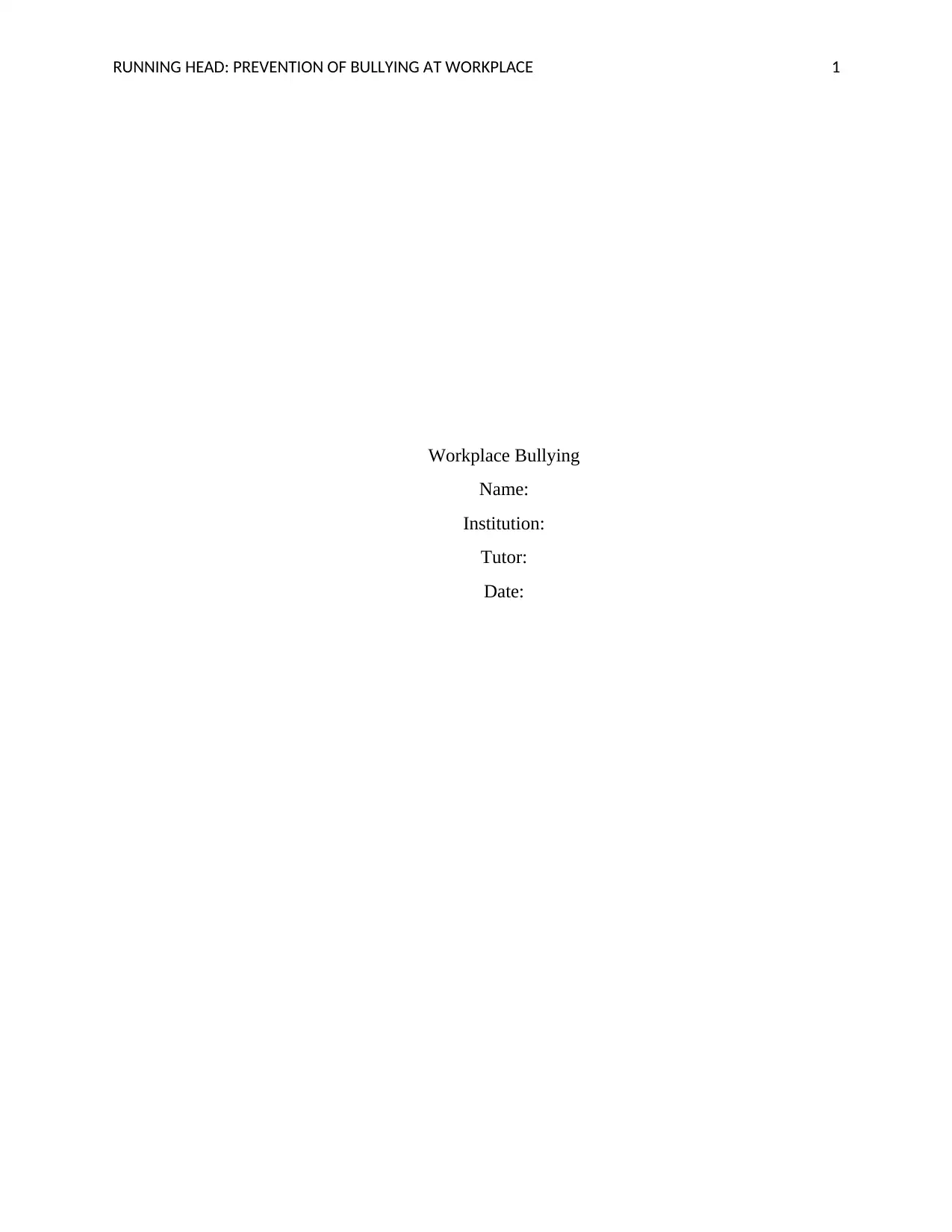
RUNNING HEAD: PREVENTION OF BULLYING AT WORKPLACE 1
Workplace Bullying
Name:
Institution:
Tutor:
Date:
Workplace Bullying
Name:
Institution:
Tutor:
Date:
Secure Best Marks with AI Grader
Need help grading? Try our AI Grader for instant feedback on your assignments.
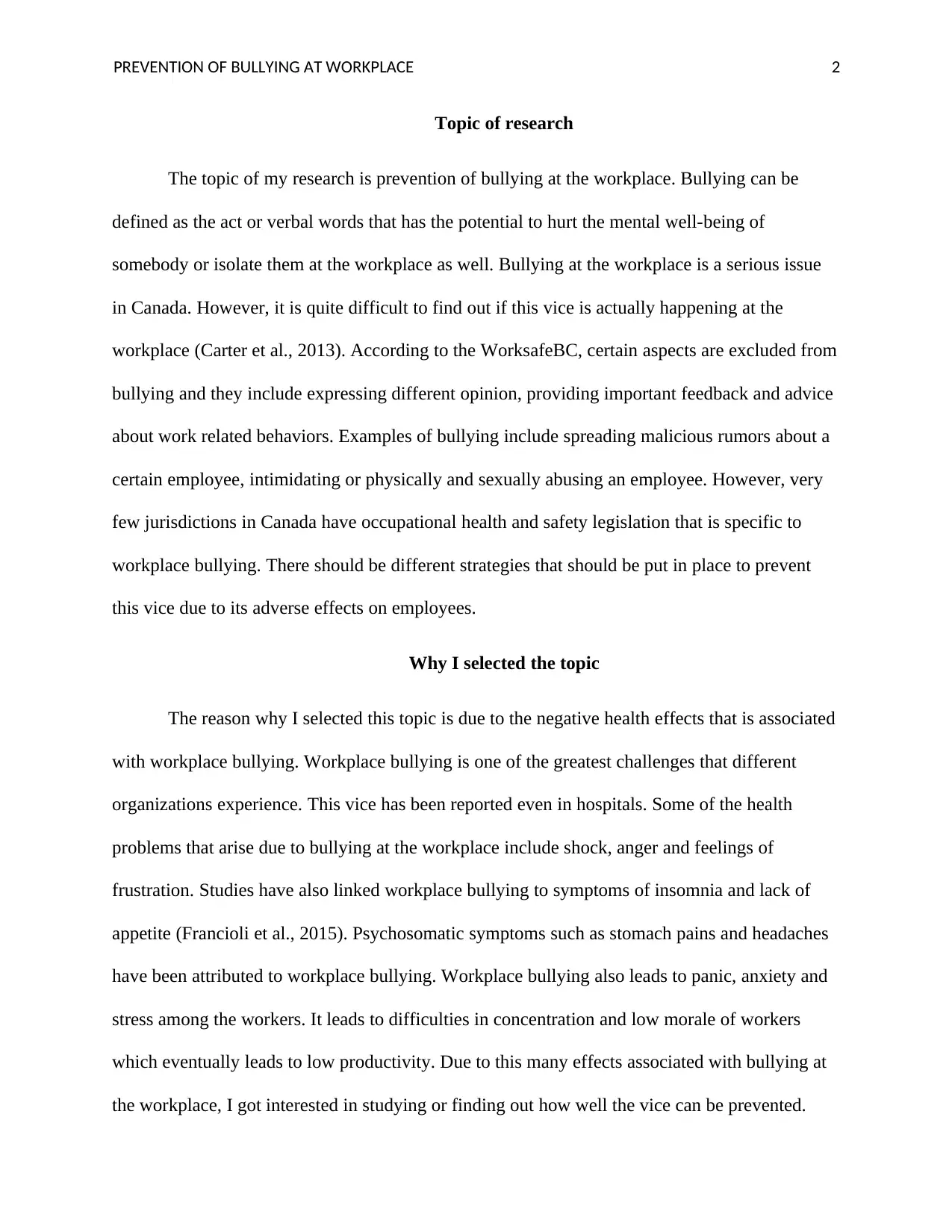
PREVENTION OF BULLYING AT WORKPLACE 2
Topic of research
The topic of my research is prevention of bullying at the workplace. Bullying can be
defined as the act or verbal words that has the potential to hurt the mental well-being of
somebody or isolate them at the workplace as well. Bullying at the workplace is a serious issue
in Canada. However, it is quite difficult to find out if this vice is actually happening at the
workplace (Carter et al., 2013). According to the WorksafeBC, certain aspects are excluded from
bullying and they include expressing different opinion, providing important feedback and advice
about work related behaviors. Examples of bullying include spreading malicious rumors about a
certain employee, intimidating or physically and sexually abusing an employee. However, very
few jurisdictions in Canada have occupational health and safety legislation that is specific to
workplace bullying. There should be different strategies that should be put in place to prevent
this vice due to its adverse effects on employees.
Why I selected the topic
The reason why I selected this topic is due to the negative health effects that is associated
with workplace bullying. Workplace bullying is one of the greatest challenges that different
organizations experience. This vice has been reported even in hospitals. Some of the health
problems that arise due to bullying at the workplace include shock, anger and feelings of
frustration. Studies have also linked workplace bullying to symptoms of insomnia and lack of
appetite (Francioli et al., 2015). Psychosomatic symptoms such as stomach pains and headaches
have been attributed to workplace bullying. Workplace bullying also leads to panic, anxiety and
stress among the workers. It leads to difficulties in concentration and low morale of workers
which eventually leads to low productivity. Due to this many effects associated with bullying at
the workplace, I got interested in studying or finding out how well the vice can be prevented.
Topic of research
The topic of my research is prevention of bullying at the workplace. Bullying can be
defined as the act or verbal words that has the potential to hurt the mental well-being of
somebody or isolate them at the workplace as well. Bullying at the workplace is a serious issue
in Canada. However, it is quite difficult to find out if this vice is actually happening at the
workplace (Carter et al., 2013). According to the WorksafeBC, certain aspects are excluded from
bullying and they include expressing different opinion, providing important feedback and advice
about work related behaviors. Examples of bullying include spreading malicious rumors about a
certain employee, intimidating or physically and sexually abusing an employee. However, very
few jurisdictions in Canada have occupational health and safety legislation that is specific to
workplace bullying. There should be different strategies that should be put in place to prevent
this vice due to its adverse effects on employees.
Why I selected the topic
The reason why I selected this topic is due to the negative health effects that is associated
with workplace bullying. Workplace bullying is one of the greatest challenges that different
organizations experience. This vice has been reported even in hospitals. Some of the health
problems that arise due to bullying at the workplace include shock, anger and feelings of
frustration. Studies have also linked workplace bullying to symptoms of insomnia and lack of
appetite (Francioli et al., 2015). Psychosomatic symptoms such as stomach pains and headaches
have been attributed to workplace bullying. Workplace bullying also leads to panic, anxiety and
stress among the workers. It leads to difficulties in concentration and low morale of workers
which eventually leads to low productivity. Due to this many effects associated with bullying at
the workplace, I got interested in studying or finding out how well the vice can be prevented.
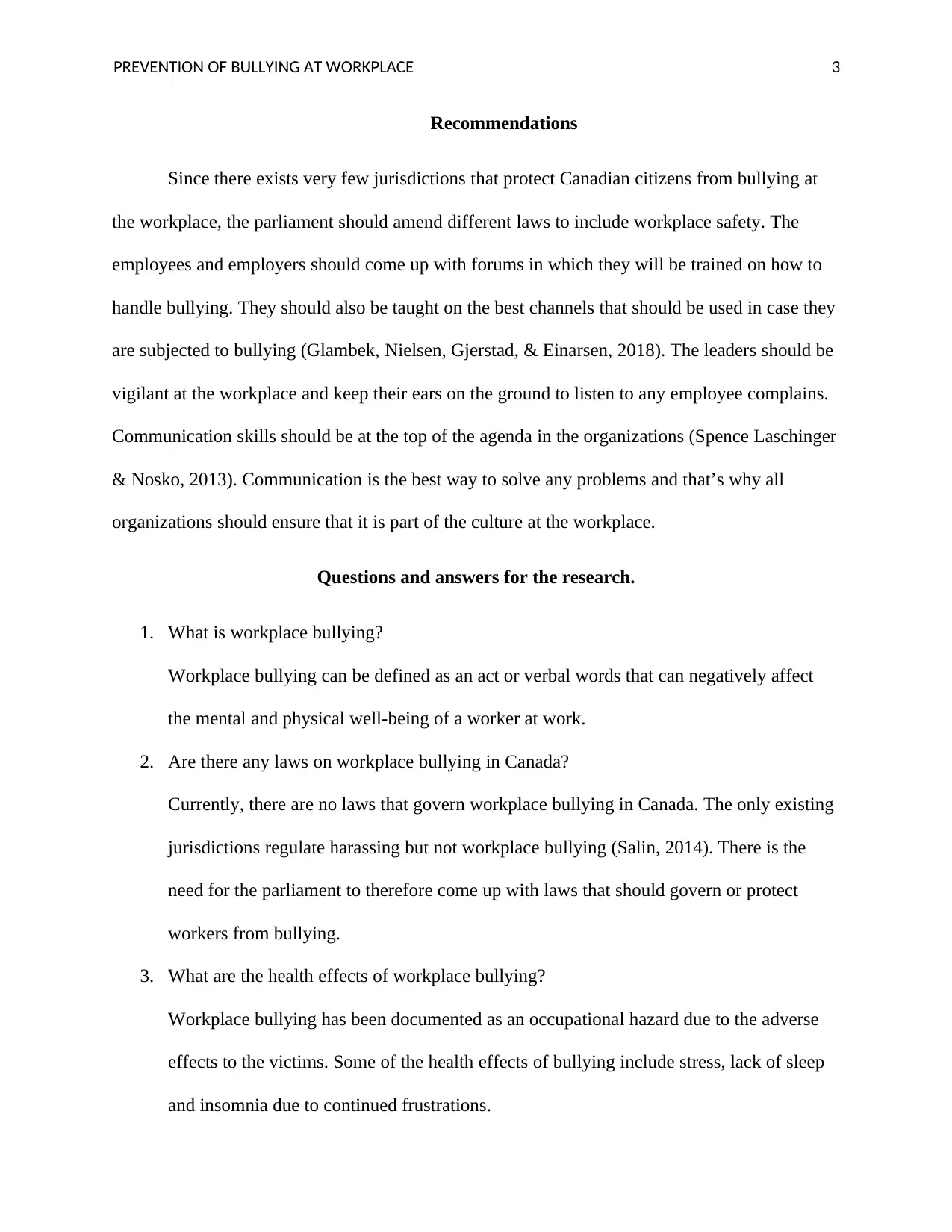
PREVENTION OF BULLYING AT WORKPLACE 3
Recommendations
Since there exists very few jurisdictions that protect Canadian citizens from bullying at
the workplace, the parliament should amend different laws to include workplace safety. The
employees and employers should come up with forums in which they will be trained on how to
handle bullying. They should also be taught on the best channels that should be used in case they
are subjected to bullying (Glambek, Nielsen, Gjerstad, & Einarsen, 2018). The leaders should be
vigilant at the workplace and keep their ears on the ground to listen to any employee complains.
Communication skills should be at the top of the agenda in the organizations (Spence Laschinger
& Nosko, 2013). Communication is the best way to solve any problems and that’s why all
organizations should ensure that it is part of the culture at the workplace.
Questions and answers for the research.
1. What is workplace bullying?
Workplace bullying can be defined as an act or verbal words that can negatively affect
the mental and physical well-being of a worker at work.
2. Are there any laws on workplace bullying in Canada?
Currently, there are no laws that govern workplace bullying in Canada. The only existing
jurisdictions regulate harassing but not workplace bullying (Salin, 2014). There is the
need for the parliament to therefore come up with laws that should govern or protect
workers from bullying.
3. What are the health effects of workplace bullying?
Workplace bullying has been documented as an occupational hazard due to the adverse
effects to the victims. Some of the health effects of bullying include stress, lack of sleep
and insomnia due to continued frustrations.
Recommendations
Since there exists very few jurisdictions that protect Canadian citizens from bullying at
the workplace, the parliament should amend different laws to include workplace safety. The
employees and employers should come up with forums in which they will be trained on how to
handle bullying. They should also be taught on the best channels that should be used in case they
are subjected to bullying (Glambek, Nielsen, Gjerstad, & Einarsen, 2018). The leaders should be
vigilant at the workplace and keep their ears on the ground to listen to any employee complains.
Communication skills should be at the top of the agenda in the organizations (Spence Laschinger
& Nosko, 2013). Communication is the best way to solve any problems and that’s why all
organizations should ensure that it is part of the culture at the workplace.
Questions and answers for the research.
1. What is workplace bullying?
Workplace bullying can be defined as an act or verbal words that can negatively affect
the mental and physical well-being of a worker at work.
2. Are there any laws on workplace bullying in Canada?
Currently, there are no laws that govern workplace bullying in Canada. The only existing
jurisdictions regulate harassing but not workplace bullying (Salin, 2014). There is the
need for the parliament to therefore come up with laws that should govern or protect
workers from bullying.
3. What are the health effects of workplace bullying?
Workplace bullying has been documented as an occupational hazard due to the adverse
effects to the victims. Some of the health effects of bullying include stress, lack of sleep
and insomnia due to continued frustrations.
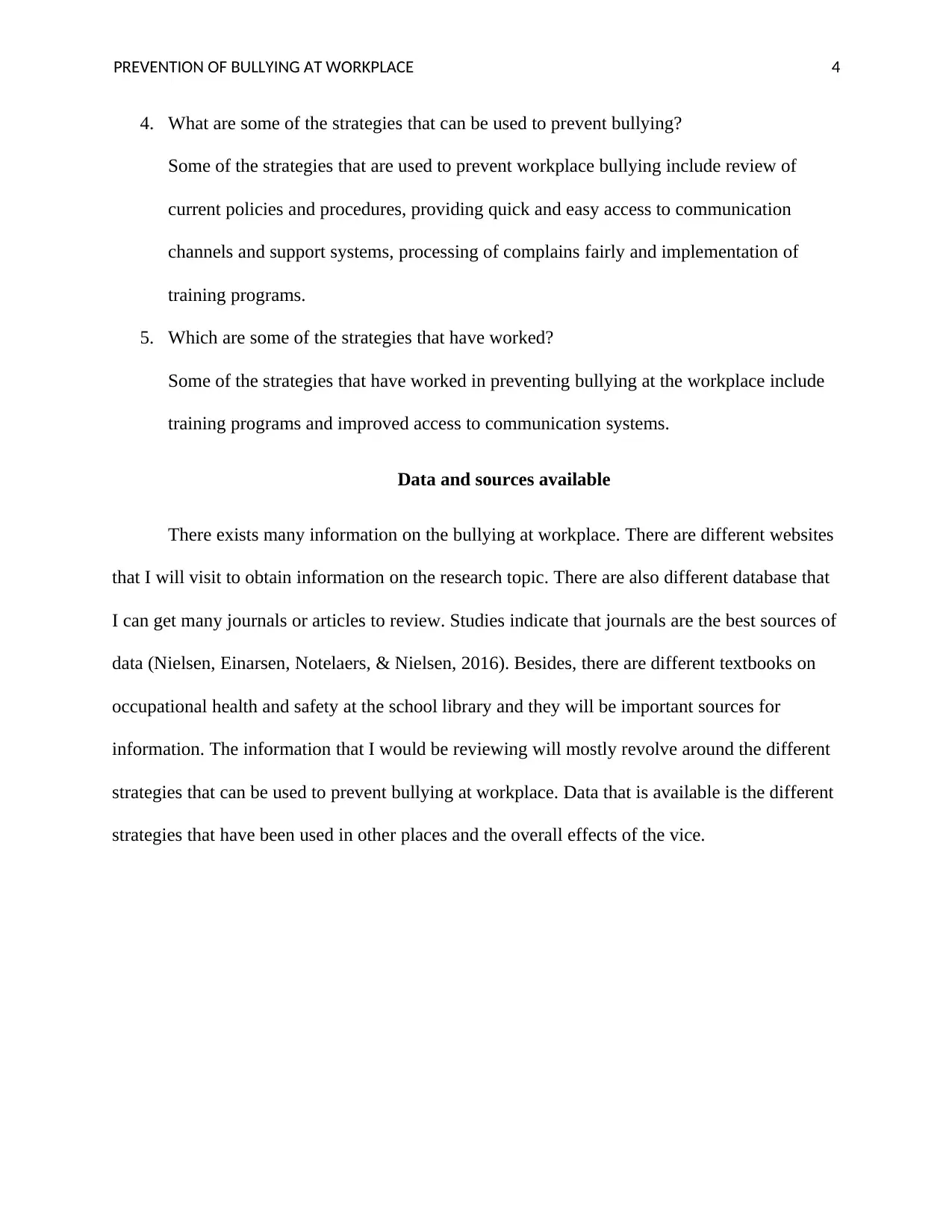
PREVENTION OF BULLYING AT WORKPLACE 4
4. What are some of the strategies that can be used to prevent bullying?
Some of the strategies that are used to prevent workplace bullying include review of
current policies and procedures, providing quick and easy access to communication
channels and support systems, processing of complains fairly and implementation of
training programs.
5. Which are some of the strategies that have worked?
Some of the strategies that have worked in preventing bullying at the workplace include
training programs and improved access to communication systems.
Data and sources available
There exists many information on the bullying at workplace. There are different websites
that I will visit to obtain information on the research topic. There are also different database that
I can get many journals or articles to review. Studies indicate that journals are the best sources of
data (Nielsen, Einarsen, Notelaers, & Nielsen, 2016). Besides, there are different textbooks on
occupational health and safety at the school library and they will be important sources for
information. The information that I would be reviewing will mostly revolve around the different
strategies that can be used to prevent bullying at workplace. Data that is available is the different
strategies that have been used in other places and the overall effects of the vice.
4. What are some of the strategies that can be used to prevent bullying?
Some of the strategies that are used to prevent workplace bullying include review of
current policies and procedures, providing quick and easy access to communication
channels and support systems, processing of complains fairly and implementation of
training programs.
5. Which are some of the strategies that have worked?
Some of the strategies that have worked in preventing bullying at the workplace include
training programs and improved access to communication systems.
Data and sources available
There exists many information on the bullying at workplace. There are different websites
that I will visit to obtain information on the research topic. There are also different database that
I can get many journals or articles to review. Studies indicate that journals are the best sources of
data (Nielsen, Einarsen, Notelaers, & Nielsen, 2016). Besides, there are different textbooks on
occupational health and safety at the school library and they will be important sources for
information. The information that I would be reviewing will mostly revolve around the different
strategies that can be used to prevent bullying at workplace. Data that is available is the different
strategies that have been used in other places and the overall effects of the vice.
Secure Best Marks with AI Grader
Need help grading? Try our AI Grader for instant feedback on your assignments.
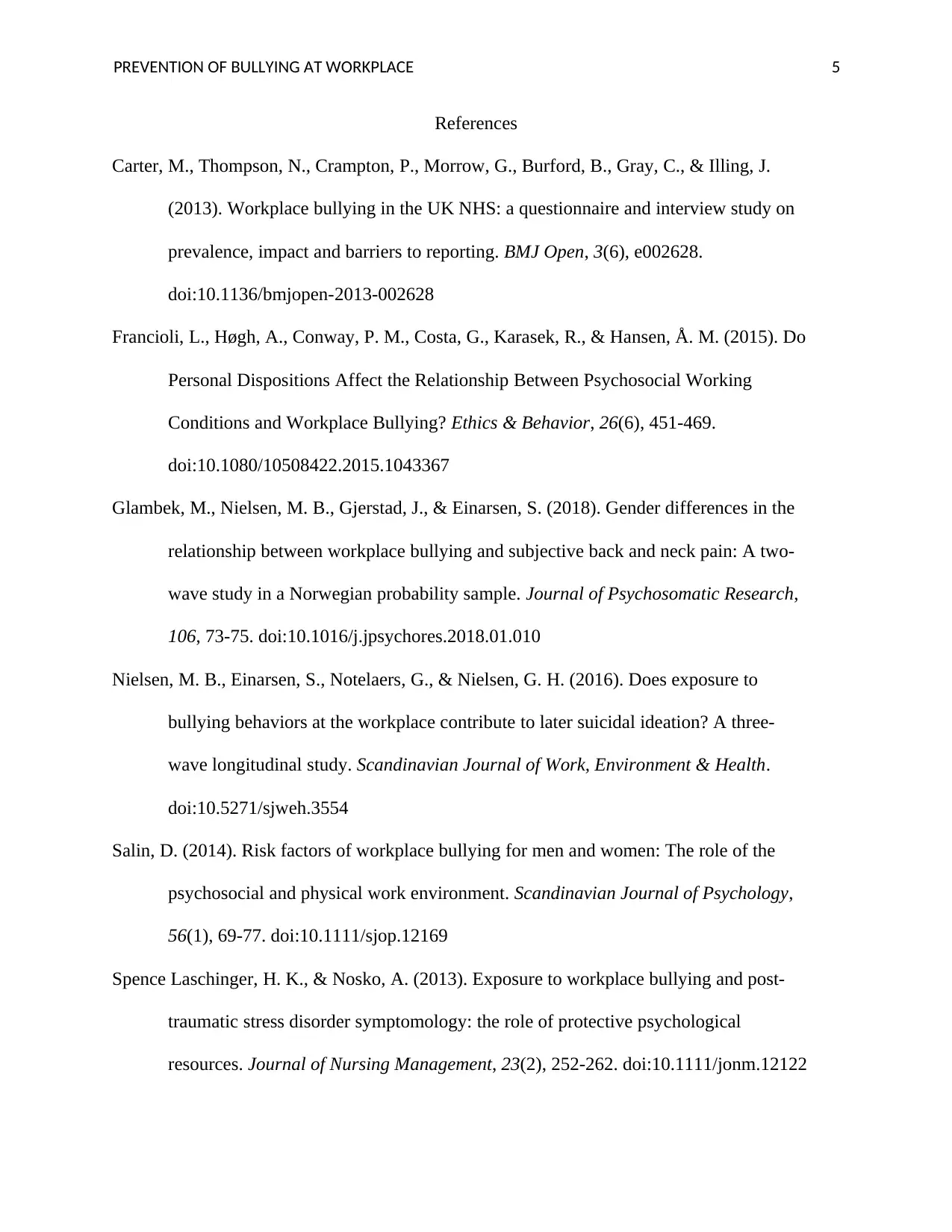
PREVENTION OF BULLYING AT WORKPLACE 5
References
Carter, M., Thompson, N., Crampton, P., Morrow, G., Burford, B., Gray, C., & Illing, J.
(2013). Workplace bullying in the UK NHS: a questionnaire and interview study on
prevalence, impact and barriers to reporting. BMJ Open, 3(6), e002628.
doi:10.1136/bmjopen-2013-002628
Francioli, L., Høgh, A., Conway, P. M., Costa, G., Karasek, R., & Hansen, Å. M. (2015). Do
Personal Dispositions Affect the Relationship Between Psychosocial Working
Conditions and Workplace Bullying? Ethics & Behavior, 26(6), 451-469.
doi:10.1080/10508422.2015.1043367
Glambek, M., Nielsen, M. B., Gjerstad, J., & Einarsen, S. (2018). Gender differences in the
relationship between workplace bullying and subjective back and neck pain: A two-
wave study in a Norwegian probability sample. Journal of Psychosomatic Research,
106, 73-75. doi:10.1016/j.jpsychores.2018.01.010
Nielsen, M. B., Einarsen, S., Notelaers, G., & Nielsen, G. H. (2016). Does exposure to
bullying behaviors at the workplace contribute to later suicidal ideation? A three-
wave longitudinal study. Scandinavian Journal of Work, Environment & Health.
doi:10.5271/sjweh.3554
Salin, D. (2014). Risk factors of workplace bullying for men and women: The role of the
psychosocial and physical work environment. Scandinavian Journal of Psychology,
56(1), 69-77. doi:10.1111/sjop.12169
Spence Laschinger, H. K., & Nosko, A. (2013). Exposure to workplace bullying and post-
traumatic stress disorder symptomology: the role of protective psychological
resources. Journal of Nursing Management, 23(2), 252-262. doi:10.1111/jonm.12122
References
Carter, M., Thompson, N., Crampton, P., Morrow, G., Burford, B., Gray, C., & Illing, J.
(2013). Workplace bullying in the UK NHS: a questionnaire and interview study on
prevalence, impact and barriers to reporting. BMJ Open, 3(6), e002628.
doi:10.1136/bmjopen-2013-002628
Francioli, L., Høgh, A., Conway, P. M., Costa, G., Karasek, R., & Hansen, Å. M. (2015). Do
Personal Dispositions Affect the Relationship Between Psychosocial Working
Conditions and Workplace Bullying? Ethics & Behavior, 26(6), 451-469.
doi:10.1080/10508422.2015.1043367
Glambek, M., Nielsen, M. B., Gjerstad, J., & Einarsen, S. (2018). Gender differences in the
relationship between workplace bullying and subjective back and neck pain: A two-
wave study in a Norwegian probability sample. Journal of Psychosomatic Research,
106, 73-75. doi:10.1016/j.jpsychores.2018.01.010
Nielsen, M. B., Einarsen, S., Notelaers, G., & Nielsen, G. H. (2016). Does exposure to
bullying behaviors at the workplace contribute to later suicidal ideation? A three-
wave longitudinal study. Scandinavian Journal of Work, Environment & Health.
doi:10.5271/sjweh.3554
Salin, D. (2014). Risk factors of workplace bullying for men and women: The role of the
psychosocial and physical work environment. Scandinavian Journal of Psychology,
56(1), 69-77. doi:10.1111/sjop.12169
Spence Laschinger, H. K., & Nosko, A. (2013). Exposure to workplace bullying and post-
traumatic stress disorder symptomology: the role of protective psychological
resources. Journal of Nursing Management, 23(2), 252-262. doi:10.1111/jonm.12122
1 out of 5
Related Documents
Your All-in-One AI-Powered Toolkit for Academic Success.
+13062052269
info@desklib.com
Available 24*7 on WhatsApp / Email
![[object Object]](/_next/static/media/star-bottom.7253800d.svg)
Unlock your academic potential
© 2024 | Zucol Services PVT LTD | All rights reserved.





